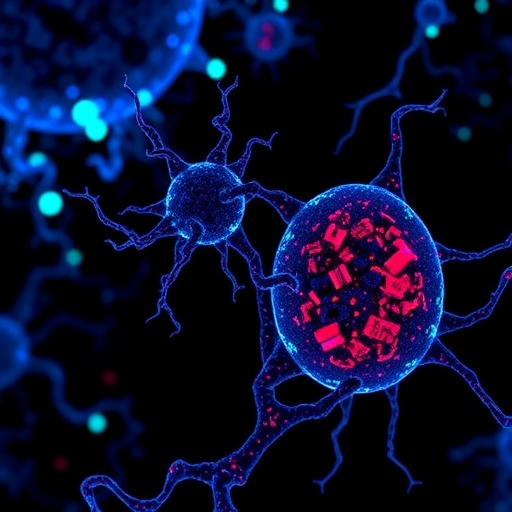In a groundbreaking study that could reshape our understanding of pulmonary fibrosis, researchers have unveiled a pivotal molecular mechanism driving fibroblast activation—a key event in the progression of this debilitating lung disease. The research, conducted by Liu, Wang, Min, and colleagues, uncovers the intricate interplay between the chemokine CCL20 and the integrin α5β1 receptor, revealing how this interaction amplifies TGF-β/Smad signaling pathways to exacerbate fibrotic remodeling within lung tissue. These revelations not only offer fresh insights into the cellular crosstalk underlying fibrosis but also highlight promising therapeutic targets aimed at halting or reversing disease progression.
Pulmonary fibrosis is characterized by excessive deposition of extracellular matrix components, leading to irreversible scarring and loss of lung function. Despite extensive efforts, the molecular drivers orchestrating fibroblast activation—the primary effector cells responsible for matrix production and tissue stiffening—have remained elusive. The study delves deeply into how CCL20, a chemokine typically associated with immune cell recruitment, assumes a novel role by directly engaging integrin α5β1 on fibroblasts. This binding event potentiates downstream profibrotic signaling cascades, particularly enhancing TGF-β-mediated Smad2/3 phosphorylation, thus promoting fibroblast proliferation and myofibroblast differentiation.
Utilizing a combination of in vitro cell culture systems and in vivo murine models of pulmonary fibrosis, the research team meticulously mapped the molecular events following CCL20-integrin engagement. Integrins, widely known as transmembrane receptors mediating cell-extracellular matrix adhesion, here demonstrate an unexpected function in immune signaling integration. Upon CCL20 binding, integrin α5β1 undergoes conformational changes that facilitate the recruitment and activation of downstream effectors in the TGF-β/Smad pathway, creating a feed-forward loop that intensifies fibrotic responses. This discovery sheds light on previously unrecognized cross-talk between chemokine receptor signaling and integrin-mediated signaling pathways.
The implications of these findings extend beyond basic mechanistic insight. The enhanced signaling cascade triggered by the CCL20-integrin α5β1 nexus offers a plausible explanation for the persistent activation of fibroblasts observed in chronic fibrotic lesions. This relentless activation sustains the pathological deposition of collagen and other matrix molecules, eventually culminating in the distortion of pulmonary architecture and impaired respiratory function. Targeting this interaction, the researchers speculate, could disrupt the vicious cycle of fibroblast activation and matrix deposition central to disease exacerbation.
Further validation came from genetic and pharmacological interventions aimed at disrupting either CCL20 expression or integrin α5β1 functionality. These approaches resulted in marked attenuation of TGF-β/Smad signaling intensity and consequent decrease in myofibroblast differentiation and collagen synthesis. Notably, lung tissue from treated animals exhibited reduced fibrotic scarring and improved physiological parameters, underscoring the translational potential of these molecular insights.
The study also highlights the dual role of CCL20 in pulmonary fibrosis pathobiology. Traditionally recognized as an immune chemokine, CCL20’s direct effect on fibroblasts indicates a more complex role in modulating tissue homeostasis and repair mechanisms. This multifunctionality challenges the existing paradigm and invites a reevaluation of chemokine functions in fibrotic diseases, encouraging exploration of other possible chemokine-integrin interactions that might influence fibrogenesis.
Central to the pathological process is the TGF-β/Smad signaling axis, a master regulator of fibrosis whose overactivation precipitates fibrotic transformation in multiple organs. The ability of integrin α5β1 to bolster this signaling underscores the integrin’s emerging role as more than a structural adhesion molecule. This insight aligns with growing evidence implicating integrins in signal transduction pathways that govern cellular behavior beyond mere adhesion, including proliferation, differentiation, and migration.
In dissecting the molecular underpinnings of fibrosis, the research team employed sophisticated imaging techniques and biochemical assays to demonstrate the co-localization and biochemical interaction of CCL20 with integrin α5β1 at the fibroblast surface. These experiments confirmed that this interaction is essential for the subsequent phosphorylation of Smad2/3 transcription factors, which drive pro-fibrotic gene expression. Thus, the study bridges a critical gap in understanding how external chemokine cues translate into nuclear transcriptional changes in fibroblasts.
This work also raises compelling questions about the origin and regulation of CCL20 production in the fibrotic lung milieu. While immune cells have been classically identified as sources of chemokines, emerging data suggest that fibroblasts themselves may secrete CCL20, potentially leading to an autocrine loop that perpetuates their own activation. The intricacies of such feedback mechanisms present fertile ground for future investigation, with important ramifications for targeted therapy development.
From a clinical perspective, these findings could revolutionize treatment approaches for patients suffering from idiopathic pulmonary fibrosis (IPF) and other interstitial lung diseases. Current therapies predominantly aim to slow disease progression rather than reverse fibrotic damage. The identification of the CCL20–integrin α5β1 axis as a critical amplifier of TGF-β signaling identifies a novel molecular axis for therapeutic intervention—one that may complement or enhance existing anti-fibrotic regimens.
Moreover, the research underscores the importance of integrins as druggable targets in fibrosis, a concept gaining traction in oncology and autoimmune disease research. Small molecule inhibitors or monoclonal antibodies designed to interrupt the CCL20–integrin connection could serve as powerful modulators of fibroblast activity and tissue remodeling. The specificity inherent in targeting this interaction portends fewer off-target effects compared to broader immunosuppressive strategies.
In addition, the study’s comprehensive approach integrating molecular biology, pathology, and in vivo models epitomizes the modern paradigm of translational research. By establishing concrete mechanistic links with therapeutic relevance, the work sets a high standard for subsequent investigations into fibrotic disease mechanisms. It also exemplifies how basic science discoveries can swiftly inform clinical innovation, a key tenet of personalized medicine.
As the burden of pulmonary fibrosis continues to rise globally, fueled by aging populations and environmental insults, there is an urgent need for novel insights and interventions. The elucidation of the CCL20–integrin α5β1 interaction illuminates previously uncharted pathways that govern fibroblast behavior and fibrosis progression. This knowledge empowers researchers and clinicians alike to devise more nuanced and effective strategies to combat the disease.
In conclusion, the study by Liu et al. represents a seminal advancement in our understanding of pulmonary fibrosis, revealing a critical molecular partnership that amplifies fibrotic signaling and cellular activation. By charting the complex terrain of chemokine-integrin interactions and their impact on canonical TGF-β/Smad pathways, the research opens new therapeutic vistas poised to transform the management of fibrotic lung disease, offering renewed hope to patients worldwide.
Subject of Research: Molecular mechanisms underlying fibroblast activation in pulmonary fibrosis.
Article Title: The CCL20–integrin α5β1 interaction enhances TGF-β/Smad signaling to promote fibroblast activation in pulmonary fibrosis.
Article References:
Liu, S., Wang, Q., Min, J. et al. The CCL20–integrin α5β1 interaction enhances TGF-β/Smad signaling to promote fibroblast activation in pulmonary fibrosis. Nat Commun 16, 9183 (2025). https://doi.org/10.1038/s41467-025-64211-6
Image Credits: AI Generated
Tags: CCL20 chemokine role in fibrosiscellular crosstalk in lung diseasechronic lung disease progressionextracellular matrix deposition in lungsfibroblast activation mechanismsin vitro and in vivo fibrosis studiesintegrin α5β1 receptor functionmyofibroblast differentiation processesnovel insights into pulmonary fibrosispulmonary fibrosis research breakthroughsTGF-β/Smad signaling pathwaystherapeutic targets for fibrosis treatment





